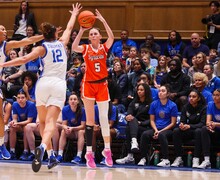Midseason adjustment, chasers helped Syracuse improve its ride this year
Andrew Graham | Senior Staff Writer
The Orange have lowered their opponents clears to under 84%.
Albany’s Lara Podvin faked a move and shifted her stick to her left as she crossed midfield, splitting Emily Hawryschuk and Braelie Kempney. The Great Danes were already trailing Syracuse 5-1 midway through the first half during their March 27 game, and Albany needed goals.
When she approached the 40-yard-line, Podvin was met by a third defender, Meaghan Tyrrell. As she advanced past Tyrrell, Podvin got her stick deflected and the ball jarred loose. Vanessa Costantino scooped the ground ball and was fouled, earning Syracuse possession. Fifty seconds later, the failed clear turned into points, as Julie Cross found Cara Quimby to extend SU’s lead to five.
Forced turnovers on clears has been common for No. 4 Syracuse (14-3, 5-2 Atlantic Coast) this season because of its improved ride unit. After allowing nearly 87% of opponents’ clears last season, the Orange have lowered that number to 83.7, including a three-game stretch against No. 6 Notre Dame, Albany, and No. 18 Duke in which the Orange stopped 24% of their clear attempts. To begin the year, one attacker stayed forward to defend the goalkeeper from facilitating the clear, but now Syracuse drops all four forwards in addition to using more players as chasers, following the ball wherever it goes.
SU made the change in strategy around the middle of the season, after its ride unit, the attackers and midfielders tasked with stopping the opponents’ clears, failed against Boston College (14-14 clears) and Florida (13-13) and stopped Virginia (16-17) and Loyola (17-18) just once each.
Since the Florida game on March 13, SU has yet to allow an opponent to go perfect on clears, producing at least two stops in seven out of eight games. But in its most-recent contests, Syracuse’s opponents have succeeded on over 90 percent of their clears, indicating inconsistency amid recent growth.
“The key is not to let the ball get out early,” Syracuse head coach Gary Gait said. “Dropping four (attackers) back, I think allows us to slow the ball down and make them take some time off the clock and I think we’ve seen that.”

Eva Suppa | Contributing Digital Designer
Rather than a man-to-man ride, the Orange utilized a zone, or “drop” ride. Instead of having each attacker up on a defender, they’ll lay back around the opponent’s 40-yard-line and wait for the defenders to get to them.
The attackers then break from their zone positions and engage the ball-handler. In the case of Podvin, that was Hawryschuk and Tyrrell, who got help from Kempney, a midfielder.
“I think it really helps us out because if we have one pressuring the goalie, that’s only three covering the width of the field,” Tyrrell said. “Having four gives us more opportunity to create the double and everyone shifts over, so it gives us more coverage.”
Most clears come following a missed shot, and Gait will insert midfielders or defenders into a role he calls a “chaser,” a role Emily Resnick, Alexis LeDoyen, Allyson Trice and Grace Fahey have all assumed. The chaser makes for more congested passing and driving lanes, further slowing down clear attempts.
“(Resnick) distracts them so we can get off and get the defense on,” Sam Swart said. “I think that helps with Emily hustling back and forth.”
Still, the strategy has betrayed SU recently, as opponents have cleared with ease. Gait explained that the inconsistency is due to the team’s up-and-down effort level at points this season. It’s natural, he said, to be tired after running the whole game and let that affect your play, but there are no excuses for not giving 100% effort on the ride.
“You get in a game and sometimes the ball just gets passed over your head,” Gait said. “You step upfield, you don’t cover behind you. Other times you make the plays. So it’s just a work in progress that we’ll continue to keep working on, and hopefully it’ll just get better as we go.”
Published on April 23, 2019 at 9:56 pm
Contact Eric: erblack@syr.edu | @esblack34






